1. Part One: Paradigms and Principles
1.1. Inside-Out
1.1.1. gist
1.1.1.1. Paradigm
1.1.1.1.1. it's the way we "see" the world
1.1.1.2. We see the world, not as it is, but as we are-or, as we are conditioned to see it
1.1.1.2.1. example
1.1.1.3. Our paradigms, correct or incorrect, are the sources of our attitudes and behaviors, and ultimately our relationships with others
1.1.1.4. The inside-out approach says that private victories precede public victories, that making and keeping promises to ourselves precedes making and keeping promises to others. It says it is futile to put personality ahead of characters, to try to improve relationships with others before improving ourselves
1.2. The 7 Habits - An Overview
1.2.1. gist
1.2.1.1. True effectiveness is a function of two things
1.2.1.1.1. what is produced (the golden egg)
1.2.1.1.2. the producing asset or capacity to produce (the goose)
1.2.1.2. P/PC Balance
1.2.1.2.1. P
1.2.1.2.2. P/C
1.2.1.3. What you can expect
1.2.1.3.1. You'll no longer build your emotional life on other people's weaknesses
2. Part Two: Private Victory
2.1. Habit 1: Be Proactive
2.1.1. gist
2.1.1.1. "You are the creator. You are in charge."
2.1.2. Quotes
2.1.2.1. Self-awareness enables us to stand apart and examine even the way we "see" ourselves-our self-paradigm, the most fundamental paradigm of effectiveness
2.1.2.2. Proactivity
2.1.2.2.1. More than merely taking initiative. It means that as human beings, we are responsible for our own lives. Our behavior is a function of our decisions, not our conditions. We can subordinate feelings to values. We have the initiative and the responsibility to make things happen
2.1.2.3. Reactive people are often affected by
2.1.2.3.1. their physical environment
2.1.2.3.2. their social environment, by the "social weather"
2.1.2.4. The ability to subordinate an impulse to a value is the essence of the proactive person. Reactive people are driven by their feelings, by circumstances, by conditions, by their environment. Proactive people are driven by values-carefully thought about, selected and internalized values
2.1.2.5. Because our attitudes and behaviors flow out of our paradigms, if we use our self-awareness to examine them, we can often see in them the nature of our underlying maps
2.1.2.5.1. e.g.
2.1.2.6. Direct, Indirect, and No Control
2.1.2.6.1. Direct Control
2.1.2.6.2. Indirect Control
2.1.2.6.3. No Control
2.1.2.7. Circle of Concerns is filled with the have's
2.1.2.7.1. I will be happy when i HAVE my house paid off
2.1.2.7.2. If only I HAD a boss who wasn't such a dictator...
2.1.2.7.3. If only i HAD a more patient husband
2.1.2.7.4. If i HAD more obedient kids...
2.1.2.7.5. If I could just HAVE more time to myself
2.1.2.8. Circle of Influence is filled with the be's
2.1.2.8.1. I can BE more patient, Be wise, BE loving
2.1.2.9. Anytime we think the problem is "out there," that thought is the problem
2.1.2.10. The Most positive way I can influence my situation is to work on my self, on my being
2.1.2.11. The proactive approach to a mistake is to acknowledge it instantly, correct and learn from it
2.1.2.11.1. Our response to any mistake affects the quality of the next moment. It's important to immediately admit and correct our mistakes so that they have no power over that next moment and we are empowered again
2.1.2.12. The power to make an keep commitments to ourselves is the essence of developing the basic habits of effectiveness
2.2. Habit 2: Begin with the end in mind
2.2.1. gist
2.2.1.1. "first, or mental creation. It's based on imagination-the ability to envision"
2.2.2. thought
2.2.2.1. Visualize the progress and the result
2.3. Habit 3: Put first things first
2.3.1. gist
2.3.1.1. work in Quadrant II
2.3.1.1.1. of Important & Urgent matter matrix
3. Part Three: Public victory
3.1. Habit 4: Think Win/Win
3.1.1. gist
3.1.1.1. Strive to find a way to win for both sides
3.1.2. Quotes
3.1.2.1. Win/Win is not a technique; It's a total philosophy of human interaction
3.1.3. Five Dimensions of Win/Win
3.1.3.1. Character
3.1.3.1.1. Three character traits
3.1.3.2. Relationships
3.1.3.3. Agreements
3.1.3.3.1. Win/Win Performance Agreements
3.1.3.4. Systems
3.1.3.4.1. For Win/Win to work, the systems have to support it. The training system, the planning system, the communication system, the budgeting system, the information system, the compensation system-all have to be based on the principle of Win/Win
3.1.3.4.2. Win/Win puts the responsibility on the individual for accomplishing specified results within clear guidelines and available resources
3.1.3.5. Processes
3.1.3.5.1. Four steps processes
3.2. Habit 5: Seek first to understand, then to be understood
3.2.1. Quotes
3.2.1.1. How often do we diagnose before we prescribe in communication?
3.2.1.2. Most people do not listen wit the intent to understand; the listen with the intent to reply
3.2.1.3. Four levels of listening
3.2.1.3.1. Ignoring
3.2.1.3.2. Selective
3.2.1.3.3. Attentive
3.2.1.3.4. Empathic
3.2.1.4. Emphatic listening gives a person "psychological air"
3.2.1.5. Four Autobiographical responses
3.2.1.5.1. Evaluate
3.2.1.5.2. Probe
3.2.1.5.3. Advise
3.2.1.5.4. Interpret
3.2.1.6. Four development stages of Emphatic listening
3.2.1.6.1. Mimic content
3.2.1.6.2. Rephrase the content
3.2.1.6.3. Reflect feeling
3.2.1.6.4. Rephrase the content and reflect the feeling
3.3. Habit 6: Synergize
3.3.1. Quotes
3.3.1.1. Valuing the differences is the essence of synergy-the mental, the emotional, the psychological differences between people
3.3.1.2. When you see only two alternatives-yours and the "wrong" one-you can look for a synergistic third alternative. There's almost always a third alternative, and if you work with a Win/Win philosophy and really seek to understand, you usually can find a solution that will be better for everyone concerned
